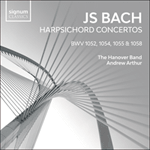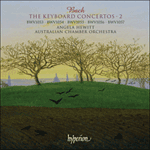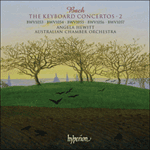‘Her playing is absolutely captivating: she decorates the solo part with playful, come-hither ornamentation—twirls, flutters, arabesques—and yet it never disturbs the clear, logical path she forges through the course of each work. Her staccato touch has the force of sprung steel and yet her legato line is a miracle of smoothness and transparency. An absolute joy’ (Gramophone)
‘Hewitt's Bach is well-known for its expressive restraint, lucid textures and rhythmic grace. These virtues are abundantly present in her thoughtful, unmannered approach to the Concertos. Contrapuntal arguments are admirably clear and Hewitt's restricted use of the sustaining pedal ensure a pleasing clarity of dialogue. These virtues are mirrored by the lightly articulated bowing of the strings of the Australian Chamber Orchestra under the direction of its leader Richard Tognetti … my own prefernce lies just with Hewitt and her Australian musicians’ (BBC Music Magazine)
‘These two discs, while available separately, go in tandem as a beguiling example of what can be achieved in performances of Baroque music on the piano when they have been prepared with such thought and are blessed with such compelling artistry as Angela Hewitt's. Her Bach catalogue for Hyperion is already extensive, and here she joins the outstanding Australian Chamber Orchestra for the six concertos and two other works that spotlight the keyboard, the Fifth Brandenburg Concerto and the A minor Triple Concerto with flute (Alison Mitchell) and violin (Richard Tognetti, who also directs the orchestra). The performances call on different traditions: Hewitt plays a modern Fazioli grand, the orchestra deploys certain historically aware techniques, to the extent of having a discreet harpsichord in the continuo part. But such is Hewitt's sensitivity to style, and such is the orchestra's versatility, that there is no sense of compromise or jarring anachronism. Rather, the two coalesce in interpretations of remarkable synergy and fascinating textures. The familiar argument that Bach would have written for a piano if only he had had one is nowhere given more persuasive advocacy than in Hewitt's singing melodic lines, her judicious range of tonal colouring and in her touch, which combines the crispness and full flavour of a fresh apple. Take a bite of any of these concertos, and you will want to make a whole meal of them’ (The Daily Telegraph)
‘Her fingers dance as well as sing: in the outer movements, rhythms are buoyantly sprung, and this communicates itself to the members of the Australian Chamber Orchestra, whose slender string accompaniment in no way lessens their energy, while Hewitt responds by projecting the piano parts with all due attention to Bach's overall texture’ (International Record Review)
‘Here the Fazioli is heard at its exquisite best, its spongey bass chords pumping with clarity, its treble caressing a heart-tuggingly beautiful legato out of the slow movement, while the dainty strings sketch an almost tongue-in-cheek pizzicato in the background. Hewitt's sense of phrase is masterful … the statements have regal import under the authoritative hands of this queen of keyboard playing’ (The Times)
‘As always, she really sparkles in the allegros, infusing the music with wit as well as technical bravura’ (The Sunday Times)
‘The result of their historically informed modern-instrument take on the music is stunning, with crisp rhythms and singing melodic lines’ (Classic FM Magazine)
‘Hewitt's performances are brilliantly alive. Her subtle lyricism adds a rich, occasionally dark dimension, possibly not as Bach himself would have envisaged, but always with a deep sense of musical integrity’ (The Scotsman)
‘These are warmly involving interpretations of pioneering pieces’ (HMV Choice)
‘Her [Hewitt's] success comes from the shaping of each concerto, these are rhythmical, warm interpretations shimmering with boundless energy and skilled virtuosity’ (Cathedral Music)
‘Her playing is absolutely captivating: she decorates the solo part with playful, come-hither ornamentation—twirls, flutters, arabesques—and yet it never disturbs the clear, logical path she forges through the course of each work. Her staccato touch has the force of sprung steel and yet her legato line is a miracle of smoothness and transparency. An absolute joy’ (Metro)


 Bach: Harpsichord Concertos Nos 1, 3, 4 & 7
Bach: Harpsichord Concertos Nos 1, 3, 4 & 7 Bach: The Keyboard Concertos, Vol. 2
Bach: The Keyboard Concertos, Vol. 2 Bach: The Keyboard Concertos, Vol. 2
Bach: The Keyboard Concertos, Vol. 2
